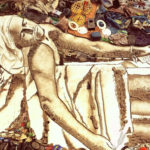The Indian government has reserved the artworks of nine masters in the government’s art treasury. Jamini Roy was one of those nine masters. This Bengali born artist was a brilliant painter. He has been awarded Padma Bhushan award as well. Who can forget 11 April 1887, the day this artist was born in Beliatore village of West Bengal. He wanted to make a career in art and thus he got enrolled in the Government School of Arts and Craft in Kolkata. He learned academic painting and portraiture there. He is popular because of a wide range of choice. He got an appreciation for his painting ‘Santhal Tribe of Bengal’.

Jamini Roy; renowned artist
One of his famous paintings, ‘Black Horse’ was also made doodle by Google on his 130th birth anniversary. Google dedicated its homepage to this Indian artist. The painting has the dark house with the yellow and red background. The painting has been made in the signature style of the artist. Roy made paintings on Jesus Christ, animals and also on the mother-child relationship. He is known to bring the positive change in the Indian modern art. He refused to continue with the then modern art style and preferred only Bengali folk style. His step was so powerful and fundamental that he received support from many. For his wise decisions and contributions, he was awarded Padma Bhushan in 1954. He is the awardee of Viceroy’s gold medal as well. This was given to him in 1934.

‘Mother and child’ by Jamini roy
This Indian artist had a very iconic signature style. The world knows him for his astonishing work on Indian folk culture and rural ethos. His artworks were so graceful and mesmerizing that accorded him worldwide recognition. He was known at national as well as international level. This Indian artist was very often compared with French artist ‘Henri Matisse’. He took lessons of western classical style but he chose to paint in typical Indian style. This is what made him more unique. He started showing interest in art since childhood. At the age of 16, he showed that he is linked to art from grass root level. Then he was sent study at the Government College of Art in Kolkata.

‘Cat and lobster’ painting by Jamini Roy
Luck favours those who strive to work hard. When he joined the school, the then vice-president was Abanindranath Tagore. He was none other than the founder of Bengal school of art. He was renowned writer and artist. He thought Roy, the classical western genre of landscapes and studio portraits. Jamini had a strong grasping power that he learned many techniques very soon. This impressed Tagore a lot. Initially, Roy painted Western classical art and the avant-garde Bengal school of art. But destiny had something to serve to Roy. His creations were not influencing enough. With time he realized that he should prepare paintings which are linked with the culture. There Jamini started trying out art and indigenous materials.
When he was in quest of the unique art style, he went through Kalighat style. This art form was known for having a presence of eyes which were of almond shape, faces which were round, a body which had beautiful curves and many more unique features. This kind of painting was done on mill-made paper. The artist used fluid brushwork and vibrant colors (especially dyes) to make it more impressive. All this was done only to bring the impact. These paintings depicted Hindu deities. This art form is supposed to have originated in Kolkata’s Kalighat temple. It had themes related to day-to-day life, tribal life and also mythological characters.
This was the inspiration Roy used to express typical rural Indian beauty. This is the reason he succeeded in painting the Santhal tribal culture of Bengal. He quit European paints, canvas and much more and preferred indigenous painting surfaces to paint. Woven mats, lime coated wood and cloth etc used to be his props. He started using natural mineral and vegetable-based pigments to color his creations. These were made up of seeds, rocks, flowers, and indigo.

‘Kalighat’ painting by Jamini Roy
Roy instead of copying the technique he added up his own style in the paintings. He used sweeping brushes and he confined his colors only to seven bright colors. They were vermillion, grey, yellow ochre, blue, cadmium green, white and Indian red. He didn’t change the feature of Kalighat paintings but with its help, he created his own signature style. This signature style led him to have a unique place in the art history.
He has portrayed his childhood life in his paintings. His famous ‘cat’ series is known to be inspired by his childhood memories. He spent his early life in the forested village of Beliatore in Bankura. He didn’t limit himself only to painting. He tried variety in sculpting skills. He worked with many wooden shapes and brought out something new. He was a good sculpture as well. It was in the 1940s he started getting worldwide recognition. He started experiencing fan following. His well-wishers belonged to India as well as Europe. His paintings have been reserved special places in people’s heart and people’s home. Even today they can be found hanged in Bengali and European households. His creations are part of calendars, school bags, saris and even in Durga Puja idols.
Roy was very down to earth that he never bothered about name and fame. He always worried about his art. He didn’t want the world to destroy his talent. This was the only reason he never sold his paintings. He rarely sold some of his sketches to people and that too on demand. He sold only a few artworks for a price higher than ₹350. On being asked why he does so, he used to reply that no one else can keep his paintings in a better way. He always scared that no one can maintain the beauty of the picture, not even those who purchased it. He knew he created a unique art and thus he wanted to retain it. He always wanted to offer his creation a unique earthy quality.

‘Vision of India’ by Jamini Roy
The then prime minister of India, Mrs. Indira Gandhi honored him with Padma Bhushan. Mahatma Gandhi was one of his admirers. He was declared a national artist. Many times his works have been exhibited on a national and international level. Life-long he worked in Calcutta. In 1972, leaving many paintings unsigned, this ultimate artist of India passed away. He was god gift to India.



What do you think?